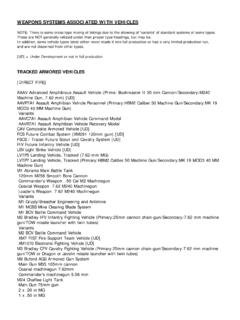Transcription of Science Enhanced Scope Sequence Drain This!
1 Science Enhanced Scope and Sequence Grade 3 virginia department of education 2012 1 Drain This! Strand: Interrelationships in Earth/Space Systems To p i c : Components of soil Primary SOL: The student will investigate and understand the major components of soil, its origin, and its importance to plants and animals including humans. Key concepts include a) soil provides the support and nutrients necessary for plant growth; b) topsoil is a natural product of subsoil and bedrock; c) rock, clay, silt, sand, and humus are components of soils. Related SOL: The student will demonstrate an understanding of scientific reasoning, logic, and the nature of Science by planning and conducting investigations in which a) observations are made and are repeated to ensure accuracy; b) predictions are formulated using a variety of sources of information; g) questions are developed to formulate hypotheses; h) data are gathered, charted, graphed, and analyzed; l) models are designed and built; m) current applications are used to reinforce Science concepts.
2 Background Information Over many years, weather, water, and living organisms help break down rocks and create soil. This breaking down is called weathering. The nutrients found in soil are important for plants to grow. Soil is made up of rock, clay, silt, sand, and humus. Topsoil is a natural product of subsoil and bedrock. It is found in the upper layer of soil. It is best for plant growth. Humus is decayed matter in soil. It is located in the top soil and adds nutrients to the soil. Clay contains tiny particles of soil which holds water; it also adds nutrients. Clay does not Drain well. Sand is made of small grains of worn down rock. It has few nutrients and drains water well. Silt is made up of very small pieces of rock. Silt particles are larger than clay but smaller than sand.
3 Materials Per group of students: Three funnels Three clear containers to hold the funnels Three coffee filters Sand Silt Clay Pitcher of water Graduated cylinder Stopwatch Quarter cup measuring cup Per student: T chart Types of Soil handout Drain This! Data Sheet handout Science Enhanced Scope and Sequence Grade 3 virginia department of education 2012 2 Create a Soil Sample handout (for assessment) Five identical pots (for extension activity) Five identical plants (plants of the same kind and size ) (for extension activity) Metric ruler Vocabulary soil, sand, silt, clay, graduated cylinder, measurement, weathering Student/Teacher Actions (what students and teachers should be doing to facilitate learning) Introduction 1. Discuss soil with students.
4 Ask them where they have seen soil, what they know about soil and why we need it. Create a KWL chart about soil. 2. Read a book about soil to the students. 3. Complete a T chart for each type of soil and its characteristics. Procedure 1. Explain to the students that they will be evaluating each type of soil and how it holds water. They will then investigate how these same soil samples affect plant growth. Discuss with the students how certain soil types are, or are not, beneficial to crops and ultimately to animals and humans. 2. Make the funnels and containers needed in this activity by using empty, clear two liter soda bottles. Mark the bottles 4 inches from the opening and cut the bottles on this line. The top part of the bottle becomes the funnel, and the bottom of the bottle can be used as the container to hold the funnel.
5 Label the three containers for each group Sand, Silt, and Clay. 4. Divide the students into groups of three or four each, and pass out the materials needed by each group. 5. Have the students place a funnel in each container, put a coffee filter in each funnel, and put exactly cup of the specified soil type for each container into its filter. 6. Have each group choose and record on the Drain This! Data Sheet a specific amount of water (mL) to use to measure the drainage speeds of the three soil samples. The group must use this exact amount for all three samples. 7. Have one student in each group measure the chosen amount of water (mL) into the graduated cylinder. When given the signal to pour, the student will pour the water immediately into the funnel containing sand.
6 8. Give the pour signal, and have another student in each group use a stopwatch to measure the time it takes for the water to Drain through the soil and filter into the container. Have the groups record this time on their data sheets. 9. Have the groups repeat steps 5 and 6 for each of the other two soil samples. 10. Finally, have one of the students in each group measure the amount of water (mL) in each of the three containers and record the three amounts on the group s data sheet. Instruct each group to use this data to calculate and record the amount of water (mL) retained in each soil sample. (Subtract the amount in the container from the original ___mL.) 11. Have the students make inferences at the bottom of the data sheet and then discuss their inferences. Science Enhanced Scope and Sequence Grade 3 virginia department of education 2012 3 Conclusion 1.
7 Have the class discuss and compare how the water drained through each sample. Which sample had the worst drainage? Why do you think that was? 2. Create a large class chart recording all data time, water drained, water retained, etc. 3. Discuss how the drainage characteristics of each sample might affect plant growth. 4. Ask the students whether they could create a good soil sample that would encourage plant growth, using all three types of soil. If so, how? Assessment Questions o Which sample of soil drained the fastest? Why? o Which sample of soil drained the slowest? Why? o Which sample of soil do you think would be the best to use for a garden? Why? Journal/Writing Prompts o Using the sample of your soil you think drains the best, you plant a garden with tomatoes, corn, and watermelon.
8 Describe your garden and tell about how well things grow for you. Other o Have the groups create a soil mixture from the three types of soil that they think will grow strong and healthy plants. They must measure and record the amount of each soil type they used. They must also record whether they layered the mixture or mixed it up. Then, have them test their sample by repeating steps 5 and 6 above. Have the students share their time results. Students complete the Create a Soil Sample handout. Extensions and Connections (for all students) Have students conduct the following experiment: o Have the students use what they know about soil drainage affecting plant growth to make hypotheses about how well plants will grow in the soils they tested (sand, silt, clay) based on the soil that drained the most and the soil that drained the least.
9 O Fill each of five identical pots with the same amount of one of the soils listed above. Label each pot according to the soil it contains. Give each student a Plant Growth Data Sheet. o Have the students plant the same type of plant in each soil. The plants and planting methods should be as identical as possible. o Have the students give the plants identical amounts of water and light over a specified period of time ( , 3 4 weeks). Have them use the metric ruler to measure and record the growth of each plant every other day during this time. Also, have them make observations on the general health of each plant. o At the end of the specified time, have the students create a graph, give results, discuss their observations, and make a final conclusion. o Explain that different plants grow in different ecosystems and different ecosystems have different types of soils.
10 How are cacti adapted to life in the desert with sand? How are cypress trees adapted to life in a swamp? o Based on the two investigations, have a class discussion about why soil should be considered important to people. Science Enhanced Scope and Sequence Grade 3 virginia department of education 2012 4 Strategies for Differentiation For the T chart, give students the characteristics on a sheet of paper. Cut and paste to match up with the type of soil. Draw a picture of what the soil looks like. Have students draw pictures of what is happening to go along with the data sheet for Drain This and Plant Growth. Have students create class gardens with various types of soil to determine effect of soil type on plant growth. Provide students with charts to compare how different types of soil affect plant development.

















